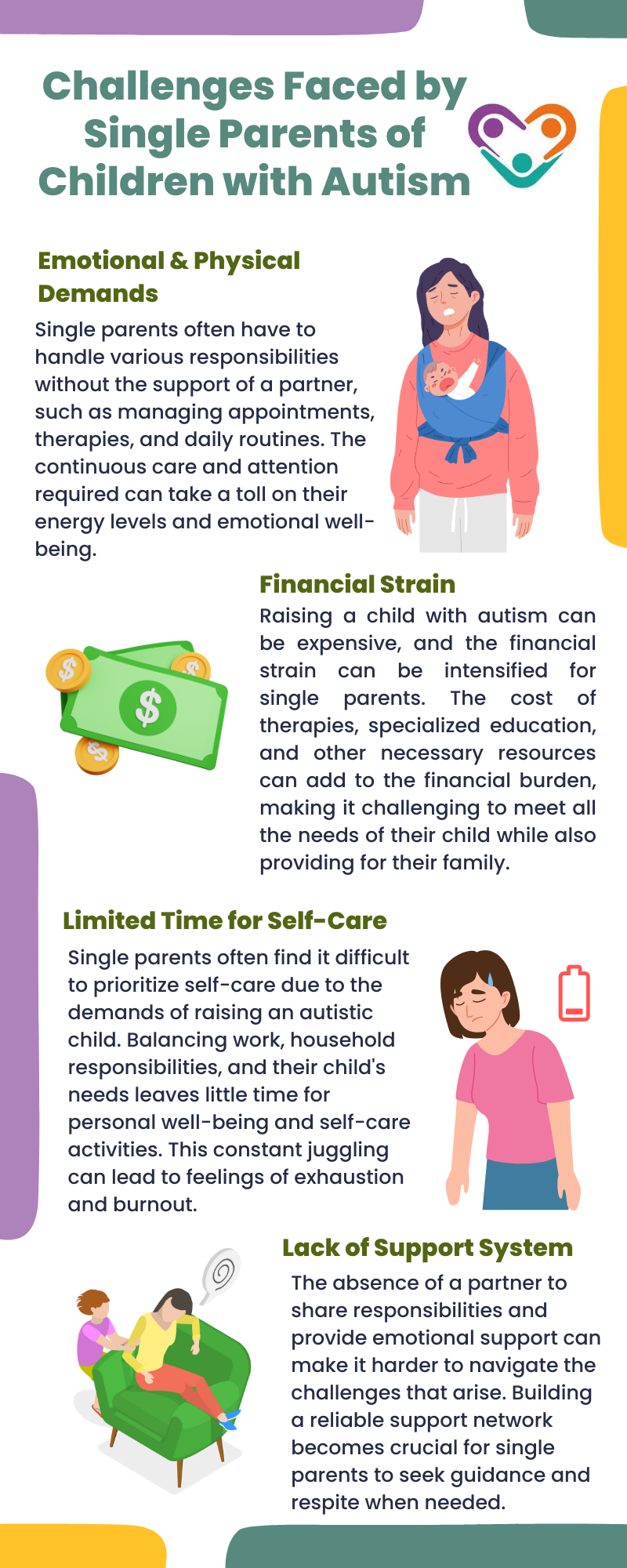
Table of Contents
Single parents of autistic children often find themselves juggling the dual demands of their child’s unique needs and their own personal responsibilities without a partner to lean on. This article aims to explore the distinct challenges and also celebrate the unique joys that come with raising an autistic child as a single parent.
We’ll share tips, stories, and ideas to help single parents feel supported and understand they’re not alone in this journey.
Single Parenting an Autistic Child
Raising a child with autism can be a demanding task, and when faced with the additional responsibility of being a single parent, the challenges can be even more significant. In this section, we will explore the personal stories of single parents and shed light on the challenges they face in raising an autistic child alone.
Take the example of Jason Miller, a single father, who had to make significant sacrifices when his son’s mother turned to drugs and alcohol after giving birth. With his son being diagnosed with autism at a young age, Jason took on the role of sole custody, becoming the primary caregiver for his almost 2-year-old son. Jason’s journey as a single dad raising an autistic child showcases his unwavering commitment and love for his son, as he gave up almost everything that defined his life to focus on raising his child.
This is just one example that highlights the immense dedication and sacrifice that single parents of autistic children make. They demonstrate the strength and love that drives these parents to give their best to their children, even in the face of adversity.
Challenges Faced by Single Parents
Single parents raising autistic children encounter a range of challenges that can be overwhelming. Some of the common difficulties include:
Despite these challenges, single parents of autistic children demonstrate incredible strength and resilience. They find ways to adapt and provide the love, care, and support their children require. Seeking support from autism communities, connecting with other single parents, and accessing available resources can help alleviate some of the difficulties faced by single parents.
Co-Parenting an Autistic Child
When it comes to raising an autistic child, co-parenting can bring its own set of challenges and triumphs.
In this section, we will explore different aspects of co-parenting an autistic child, including communication during separation, joint custody arrangements, and the option of bird-nesting.
Communication During Separation
When parents of an autistic child decide to separate, open and honest communication becomes crucial. It is important for both parents to have a conversation with the child about the upcoming changes and reassure them that they will continue to be supported and loved. Explaining the situation in a clear and age-appropriate manner can help the child better understand the changes in their family dynamics.
Maintaining effective communication between co-parents is also essential. Regular and respectful communication allows for the sharing of information about the child’s needs, progress, and any challenges they may be facing. This collaboration helps ensure consistency and enables both parents to work together in the best interest of their child.
Joint Custody Arrangements
In many cases, separations involving an autistic child result in joint custody arrangements. Joint custody allows the child to maintain contact with both parents, fostering a sense of stability and ensuring that they have ongoing relationships with both caregivers. This arrangement can be beneficial for the child’s emotional well-being and overall development.
When establishing joint custody, it is important for both parents to create a parenting plan that outlines the schedule, responsibilities, and expectations for each parent. This plan can include details such as visitation schedules, school involvement, medical decisions, and any therapies or interventions the child may require. By having a clear and comprehensive plan in place, co-parents can minimize confusion and provide a consistent and structured environment for their child.
Bird-Nesting as an Option
Bird-nesting is an alternative co-parenting arrangement that may be suitable for some families with an autistic child. In this arrangement, instead of the child moving between two different homes, the child stays in one home while the co-parents take turns living in that home. This approach allows the child to have a more stable living situation and reduces the disruptions that can come with transitioning between different environments.
Bird-nesting can be particularly beneficial for children who require significant support and assistance from both parents. It allows for a consistent routine and environment, reducing the stress and anxiety that can be triggered by changes in living arrangements. However, it is important for co-parents to establish clear guidelines and boundaries to ensure the success of this arrangement.
Co-parenting an autistic child requires ongoing communication, cooperation, and flexibility between both parents. By working together and prioritizing the needs of their child, co-parents can create a nurturing and supportive environment that allows the child to thrive.
Unique Experiences of Autism
Raising an autistic child alone brings about unique experiences that can shape family dynamics and highlight sensory sensitivities. Understanding and navigating these aspects are crucial for parents and caregivers in providing the best support for their child.
Family Dynamics and Differences
Each family has its own dynamics, but when raising an autistic child alone, these dynamics can take on a different dimension. Having an autistic child means that the family may face challenges in communication, social interactions, and understanding the world in unique ways.
As a result, it is important for the parent to create an environment that fosters acceptance, support, and understanding. By surrounding themselves with individuals who accept and celebrate these differences, families can build a strong support network that provides comfort and encouragement.
Sensory Sensitivities
Sensory sensitivities are a common aspect of autism, and they can greatly impact the daily lives of individuals on the spectrum.
To adapt and cope with sensory sensitivities, the family has developed strategies to navigate new situations. They are vigilant about potential triggers and take proactive measures to manage them. This may involve speaking up for their needs, taking breaks to regroup, and prioritizing activities that help balance their senses, such as maintaining good nutrition, getting sufficient sleep, spending time outdoors, and engaging in exercise.
Understanding and accommodating sensory sensitivities is crucial for parents and caregivers of autistic children. By being mindful of these sensitivities and implementing strategies to support their child’s sensory needs, parents can create an environment that promotes comfort and reduces potential challenges.
Coping Strategies and Adaptations
Raising an autistic child alone can present unique challenges, but with the right coping strategies and adaptations, parents and caregivers can provide the necessary support and create a nurturing environment. In this section, we will explore two important aspects of coping with autism: managing sensory overload and developing emotional sensitivities and coping mechanisms.
Managing Sensory Overload
Individuals with autism often experience sensory sensitivities that can make everyday life challenging. Sensory overload happens when an individual gets overwhelmed by sensory stimuli like bright lights, loud noises, or strong smells. It can lead to anxiety, meltdowns, and a feeling of being overwhelmed.
To manage sensory overload, it is important to be vigilant about potential triggers in new situations. Creating a predictable and structured environment can help reduce anxiety and provide a sense of comfort for the individual with autism. This can include establishing routines, creating quiet spaces for relaxation, and using visual schedules or social stories to prepare for new experiences.
Taking breaks and allowing time for individuals to regroup and recharge is also crucial. This can involve providing opportunities for quiet time, engaging in calming activities like deep breathing exercises or sensory play, and ensuring that the individual has access to their preferred sensory tools or objects. It is important to remember that each individual with autism may have different sensory preferences and needs, so it is essential to listen to their cues and provide the necessary support accordingly.
Prioritizing good nutrition, sleep, fresh air, and exercise can also help to balance the senses. A well-balanced diet, adequate sleep, spending time outdoors, and engaging in physical activities can contribute to overall well-being and help regulate sensory input.
Emotional Sensitivities and Coping Mechanisms
In addition to sensory sensitivities, individuals with autism may also have heightened emotional sensitivities. They may experience difficulty processing and regulating emotions, leading to intense reactions or emotional overload. It is important to recognize and understand these emotional sensitivities in order to provide appropriate support.
Creating a safe and accepting environment is crucial for individuals with autism. Surrounding themselves with trusted individuals who accept them completely can help protect them from emotional overload. Establishing clear and consistent communication channels can also aid in expressing emotions effectively.
Individuals with autism often require significant downtime to recover and recharge mentally. Engaging in social activities and interactions should be balanced with adequate time for rest and relaxation. This downtime allows individuals to process and regulate their emotions and prevent emotional overload, commonly referred to as “social hangovers.”
Overanalyzing situations can be a tendency for individuals with autism, leading to anxiety. However, cultivating self-awareness and developing strategies to counteract this tendency can be beneficial. These strategies may include mindfulness techniques, journaling, or seeking professional guidance to navigate and manage anxiety effectively.
By understanding and addressing sensory sensitivities and emotional sensitivities, parents and caregivers can create an environment that supports the well-being of their autistic child. Each individual with autism is unique, so it is important to adapt coping strategies based on their specific needs and preferences. Through patience, understanding, and ongoing support, the journey of raising an autistic child alone can be navigated with resilience and positivity.
Journey to Belonging
As a single parent or caregiver, the journey towards finding a sense of belonging can be both fulfilling and arduous. In this section, we will explore two key aspects of this journey: seeking comfort and acceptance, and navigating challenges with resilience.
Seeking Comfort and Acceptance
For families raising an autistic child, seeking comfort and acceptance becomes a vital part of their journey. The family, including the parent and the child, may have heightened sensitivity not only to sensory stimuli but also to emotions. As a result, they often seek to surround themselves with trusted individuals who accept them completely.
Engagement in socializing is important, but it is equally crucial for the family to have sufficient downtime to recover and recharge mentally. This downtime allows them to process their experiences and emotions in a way that is comfortable for them.
Throughout their journey, the family may come to realize that true belonging is about being in a place where they feel comfortable and accepted. It is about finding a community that understands and supports them. This may involve making changes and adaptations to their environment to better suit their needs. By actively seeking a place where they can continue to adapt and grow, they can find the comfort and acceptance they desire.
Navigating Challenges with Resilience
Raising an autistic child alone presents various challenges, but single parents and caregivers demonstrate remarkable resilience in navigating these obstacles. They face the everyday struggles of managing their child’s unique needs, juggling responsibilities, and advocating for their child’s well-being.
Resilience is built upon a foundation of self-awareness and adaptability. Single parents and caregivers learn to recognize their own strengths and limitations, as well as those of their child. They develop strategies to overcome challenges and find creative solutions to meet their child’s specific needs.
Navigating the challenges of raising an autistic child alone requires perseverance and determination. It may involve seeking support from professionals, joining support groups, or connecting with other families in similar situations. By building a network of support, single parents and caregivers can find guidance, empathy, and encouragement along their journey.
Sources:
https://www.autismspeaks.org/blog/my-story-single-mom-autism-raising-child-spectrum
https://www.2houses.com/en/blog/co-parenting-an-autistic-child-everything-you-need-to-know
- Autism Routine Disruption in Adults: Coping Tips - July 16, 2024
- Autism and Obsession: An Overview - July 16, 2024
- Autism and Taking Clothes Off: Management Tips - July 16, 2024




